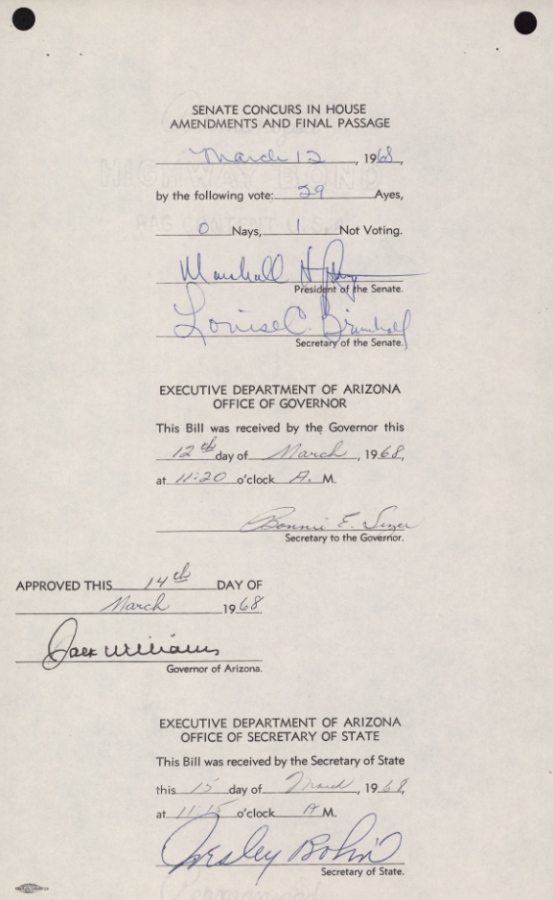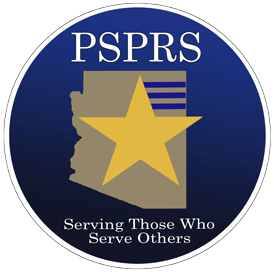LOOKING BACK AT PSPRS, ARIZONA & THE WORLD
Jack “One-Eyed” Williams, Arizona's 13th governor inked his signature on two Senate bills on March 14, 1968, creating PSPRS and a unified retirement system for first-responders.
Senate Bill 224 created the agency and its duties to Arizona. Senate Bill 211 provided the money to get PSPRS up and running while also outlining its financial responsibilities. At his desk in the Executive Tower, Williams was joined by five police administrators (pictured left to right: Bill Moore, James Polito, Richard Yealey, Ed Broad and Vance Bingaman) and four fire officials (pictured left to right: John Hughes, Paul Sanders, Benny Ashley and Lindon Vincent).
LEGISLATION
Senate Bill 224 passed the Arizona Senate on February 29, 1968, with 26 ayes, two nays and two senators not voting. At the House of Representatives, the bill passed by a landslide a week later with 52 ayes, zero nays and eight reps not voting. SB 224 made its way to the governor's desk on March 12 at 11:20 a.m., along with SB 211 which pulled public safety retirement funds from state and local employers and put the sum under control of the new agency.
Two days later, Williams signed the bills and PSPRS was born.




MEANWHILE IN 1968
The late 1960s and early 1970s were known as the “good government era” and leaders included then-Senator Sandra Day O’Connor, who went on to become the nation’s first female U.S. Supreme Court justice.
On a national and global scale, things were much more chaotic. Assassins murdered the Reverend Martin Luther King Jr. and U.S. Senator Robert F. “Bobby” Kennedy. The Vietnam War was in full-swing as the Viet Cong launched the Tet Offensive, North Koreans captured the USS Pueblo and took the surveillance crew hostage, but Americans would send Apollo 8 – the first manned spacecraft – to orbit the moon.


Entertainment in 1968 brought cinematic classics to the big screen like Planet of the Apes, Rosemary's Baby and Night of the Living Dead. A movie ticket back then was $1.50; a T.V. set, in black and white, ranged from $125 to $575 while a color console was priced between $349 to $975. Bonanza was one of the top-rated primetime television series as was Gunsmoke, The Dean Martin Show, The Beverly Hillbillies and Bewitched; "60 Minutes" debuted on CBS that year as well. The Beatles, Aretha Franklin, The Temptations, Bee Gees, Stevie Wonder, Diana Ross, The Doors and The Beach Boys populated the airways.
What could money get you in 1968? Minimum wage was $1.60 an hour and the median household income was $7,743. Gas was priced at 34 cents per gallon, a copy of The New York Times cost a dime, a dozen eggs cost 53 cents, a loaf of bread was 22 cents, a gallon of milk was 95 cents, Pillsbury cake mix cost a quarter and a six-pack of Pepsi was 59 cents. Another classic was created that year: McDonald's first Big Mac was served, and it cost 49 cents.











